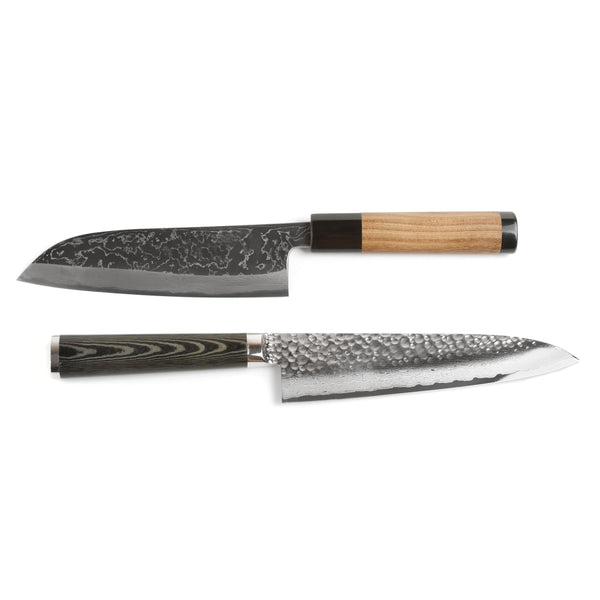
Jump to:
If you’re looking for a Japanese knife, all the different knives available may leave you confused. When you look around, you’ll notice there are about ten different styles. If you’re new to Japanese knives, names like nakiri, takohiki and yanagiba make it difficult to know which knife is right for you. Today we’re going to compare two popular Japanese knives: gyuto vs santoku. Why was the gyuto knife invented? What is a santoku knife used for? Which knife is best for you? We'll answer all your questions and more.
The first step in picking a Japanese knife is deciding whether you’re going to buy a traditional or modern knife. Traditional Japanese knives are extremely sharp, but there’s a steep learning curve if you’ve never used them before. Even in Japan, most home cooks and professional chefs opt for modern knives, because they’re easier to use and maintain. They’re also much less prone to damage.
Gyuto and santoku are modern all-purpose knives. They’re not specialty knives, but tools you can rely on to handle most tasks in the kitchen. Read on to learn about the subtle differences between the two most popular Japanese knives.
About Japanese Knives
In recent years, Japanese knives have seen growing popularity in the west. This is partly because of the high-quality materials used. Japanese knife makers focus on using the best materials available, and we find many of the best cutlery steels in the world in Japan. High-carbon blue steel like Blue Super, and stainless steels like HAP40 are the finest materials to make sharp and durable blades.
Besides the materials, the expertise and skill of Japanese blacksmiths is unmatched. In 1876, the Meiji government of Japan issued the Haito Edict. This new law prohibited all people, including samurai, from carrying swords in public. This ended the samurai class and forced Japan’s large number of expert blacksmiths to adapt.
One way Japanese blacksmiths adapted was by pivoting into making knives. People who’d spent decades mastering the art of the samurai sword began using the same materials, the same equipment, and the same techniques to produce exceptional kitchen knives.
Japan’s blade masters pass down centuries of knowledge to each new generation. They carry the spirit of the samurai sword forward in every blade.
What Is a Gyuto Knife?

The gyuto knife is a modern all-purpose chef knife. They have a narrow profile and a curved belly, culminating in a sharp tip. They’re similar in design to a western chef's knife. Most professionals in the west who use Japanese knives use gyuto.
When Japan opened to the west in the late 1800s, foreign culture started influencing all aspects of life. People began eating beef and poultry. This posed a problem, as traditional Japanese knives were designed for vegetables and seafood.
The traditional single-bevel blade is very thin, so it can chip and bend when cutting muscle and sinew. Japanese blacksmiths wanted to use traditional techniques and high-quality materials to make a chef knife which could cut through beef without breaking.
The result was a versatile and agile kitchen knife that can withstand most jobs in the kitchen while retaining its edge. Gyuto knives’ similarity to western knives makes them simple for anyone around the world to pick up and start using.
What Is a Gyuto Knife Used For?

“Gyuto” is Japanese for “beef knife”, so you can probably guess what they’re best at cutting. A gyuto knife is the ideal tool for slicing through thick cuts of steak or other large pieces of beef. Its long, curved blade makes it ideal for breaking down chickens and turkeys, and its pointed tip allows for precision cutting.
Although gyuto knives are partial to meat, they are excellent for almost anything else you’d need. The double-bevel design of the blade means that whether your knife is carbon steel or stainless steel, it will be durable. They’re well-suited for slicing and dicing hard vegetables like daikon and pumpkin, without dulling the edge of the blade.
The gyuto is a versatile knife. They can chop herbs, slice bread, and even filet fish. You can use your gyuto to cut, chop, skin and debone. If you only want to rely on one knife, and you’re used to western-style knives, a gyuto is the best pick for you.
How Is a Gyuto Knife Used?

Japanese chefs started using western cutting techniques when they started cutting meat with western-inspired knives. Gyuto knives are very similar in form to western chef knives, so we use them in much the same way.
The rock chop technique is the most popular way of cutting with a gyuto knife. It’s ideal for slicing and dicing herbs and soft vegetables. The rock chop involves cutting with the tip of the blade pointing toward the cutting board. You cut with a downward motion, and once the tip hits the board, you push down, allowing the knife to rock from the tip to the handle along the curve of the blade.
If they’re cutting meat and other proteins with a gyuto, chefs press the belly of the blade on the item, and pull it toward them as they slice. If they’re cutting harder vegetables like potatoes, daikon and carrots, they use a pushing motion.
What Is a Santoku Knife?

The santoku knife has a wide and straight blade which is shorter than most kitchen knives. Santoku rarely get longer than 7 inches. They’re all-purpose kitchen knives, and can perform a variety of cutting tasks. Santoku blades are much thinner than western kitchen knives, so they’re ideal for precise slicing and dicing.
A Japanese blacksmith invented the santoku knife in the Showa period based on usuba knives, which are single-bevel specialty knives used for cutting vegetables. Because santoku knives have a double-bevel blade, we can use them for more than one purpose.
Since the 1950s, santoku knives have been a popular choice among Japanese home cooks because of their light weight and easy handling. They are not traditional knives, but by combining the best qualities of Japan’s specialist knives, the santoku knife becomes a knife that can handle all kinds of tasks.
You can read more about santoku knives in detail here.
What Is a Santoku Knife Used For?

The name “santoku” means “three virtues” in Japanese. Some believe the three virtues are the methods of using a santoku: mincing, slicing, and dicing. Others believe it refers to what a santoku can cut: fish, meat and vegetables.
Santoku knives have sheepsfoot blades. A sheepsfoot blade has a wide curve from the spine to the flat edge. Sheepsfoot blades are easy to control, but lack the sharp tip of other knives, which makes them less versatile overall. Without a sharp point, scoring and other detailed cutting work is more difficult.
The flat edge allows complete contact with the cutting surface, resulting in clean, precise, and uniform cuts with very little effort. Full contact with the cutting board makes santoku ideal for cutting through hard vegetables. The shorter blade length means they are easier to maneuver in tight spaces and much lighter than equivalent knives.
Santoku blades are similar in design to traditional cleavers, but that doesn’t mean they’re specialty knives just for meat. In fact, they excel at cutting vegetables, and can also cut fish and fruit without trouble. They are multi-purpose knives that can cut just about anything you’d want to cut.
How Is a Santoku Knife Used?

Santoku are best suited to chopping with an up and down motion. They have flat blades, so rock chopping isn’t possible. Santoku blades reduce the risk of food slipping during the chopping motion, which makes them safe and easy for both professional and home cooks.
Start by holding your santoku flat and press against what you’re about to cut. Push down and forward, keeping the knife straight until you make contact with the board. This will cause a clean, uniform cut.
The santoku cutting technique means you’re not leaving any part of the blade in constant contact with the board. You use the entire length of the blade and prevent dulling the tip.
The up and down cutting motion of santoku knives means they require much less space than other knives, and we can use them in tight spaces and on narrow chopping boards. A santoku knife is an excellent choice for anyone who wants to cut more efficiently and save space.
Gyuto vs Santoku: What Are The Similarities?

As you would expect, gyuto and santoku have many similarities because they were created for the same purpose.
Opening to the west created a market in Japan for modern knives that could cut beef without breaking. The single-purpose knives of the time were fragile and expensive. Japanese chefs needed durable, multi-purpose kitchen knives. So when you’re comparing gyuto vs santoku, keep in mind that they were both developed as versatile knives capable of cutting beef without damaging the blade.
The primary quality these two knives share is their versatility. Both knives are suitable for mincing, slicing and dicing. We can use them on a wide range of fruit, vegetables, meat and seafood.
They’re both multi-purpose knives with thinner blade profiles than traditional Western-style knives, making them easy to use and maneuver. Their blades both start thick at the heel of the blade, and get thinner toward the tip. Gyuto and santoku are usually double-bevel knives, but there are single-bevel versions too, so be careful. These knives are excellent for beginners because the bevel and blade profile makes them easier to learn.
Both knives are available in high-carbon steel, stainless steel and ceramic, and they’re both easy to find at various price points, with many affordable options available.
Gyuto vs Santoku: What Are The Differences?

There are a few subtle differences between gyuto and santoku knives that change the way we use them. For example, gyuto knives have curved blades while santoku knives are much flatter. This difference allows the gyuto to be better for western cutting techniques, while santoku knives are better for clean cutting and slicing.
Santoku knives have a sheepsfoot blade. Sheepsfoot blades feature a wide curve from the spine to the edge. This gives the santoku knife its signature flat cutting edge. The flat edge of the santoku allows for cleaner cuts and helps to maintain the integrity of the ingredients - no squishing soft vegetables.
Gyuto knives don’t have sheepsfoot blades, so their cutting edges are curved, and they feature useful pointy tips. The gyuto’s curved blade makes them ideal for rock chopping, and the sharp tip allows for precision cutting and scoring.
Japanese blacksmiths modeled gyuto after European chef knives, while they modeled santoku after traditional Japanese knives. Both knives offer a range of benefits. The gyuto is more versatile, but the santoku knife allows greater stability and uniformity. Gyuto are partial to cutting meat, while santoku are partial to vegetables. Though both knives are multi-purpose, and designed to cut through anything.
A major difference between the two is blade length. Santoku are never longer than 7 inches, which makes them perfect for smaller chopping boards or cramped kitchens. The shorter blade length is also beneficial because it reduces the risk of the blade slipping and causing injury.
There are different sizes of gyuto, some smaller than santoku, and some up to 12 inches long. This makes them much more efficient at cutting through large slabs of beef and pork. However, the longer the blade, the more difficult it becomes to control.
Other Considerations.

There are other things to consider when you choose a Japanese kitchen knife. The most important is material. Most Japanese knives will be high-carbon or stainless steel. Gyuto and santoku knives are available in both. High-carbon steel is sharper than stainless steel, and is the gold-standard for cutlery, but it’s prone to corrosion and chipping.
However, Japanese stainless steel is also very sharp. The difference in sharpness between a high-carbon knife and a stainless one is negligible for most amateur cooks. The benefit of stainless steel blades is that they’re a little more durable. You don't have to worry about keeping them dry, and they don’t require as frequent sharpening.
Another thing to consider before buying a Japanese knife is bevel. We’ve talked about bevel a lot in this article, because while most Japanese knives have a single bevel, most gyuto and santoku knives have a double bevel - this means they're sharpened on both sides of the blade. However, some companies make single-bevel gyuto and santoku knives. Single-bevel knives are much sharper, but also more fragile and prone to breaking. So be careful when you’re shopping to confirm you’re getting the right blade.
The last consideration is whether you want a knife with a Granton edge. Granton edge knives have small divots on the blade, which reduce the surface area when cutting, and prevent food from sticking. Santoku with Granton edges are easier to find, so if this is important to you, that’s the way to go.
Which Knife Should I Choose?
Since gyuto and santoku knives can do a lot of the same things, the best knife for you depends on your preference. We will compare two profiles to see which is better for you.
Chef A is used to western cutting techniques like rock chopping, and they would like to continue to use those techniques. They have plenty of room to work and a large chopping board. They’d like a larger chef knife to cut through bigger slabs of meat. But they also work with vegetables, fruit and seafood. They need a sharp tip for fine cutting and scoring. The most versatile chef knife available is what they need.
Chef B would like to try something a little different from usual. They’re interested in using a Japanese knife more in the style of traditional Japanese knives. They’re limited on space, so they’d like a shorter knife to use an up-and-down cutting technique. It's important for them to get a clean and uniform cut every time they cut vegetables. But they also cut fruit, meat and seafood. They don’t do a lot of fine cutting and scoring, so they don’t need a sharp tip. They’d like something that’s light and easy to handle.
Both would be happy with either a gyuto or santoku. But we need to know, in the case of gyuto vs santoku - which is the best knife for them?
The best possible knife for Chef A is a gyuto. It’s partial to cutting beef, has a curved blade for western techniques, can come in a range of lengths, and is the most versatile Japanese kitchen knife on the market.
The ideal knife for Chef B is a santoku. It cuts vegetables with clean and uniform cuts every time. The santoku knife is compact, lightweight, and easy to handle. It’s a modern knife modeled after traditional Japanese knife styles, and it’s the most popular knife in home kitchens in Japan.
If neither of these profiles applies to you, maybe a different Japanese knife would be better. You can read all about the different types of Japanese knives here.


0 comments